While overshadowed by Austin in recent years, Bexar County and San Antonio are still a keystone of the Texas economy. Joining Austin as the southwestern part of the Texas Triangle, Bexar County is a powerhouse alongside the other tentpoles of Houston and DFW. One of the most diverse counties in the United States, Bexar has many cultures, businesses, and economic factors that have historically made the area one of the most important in the state. With over two million people within its borders, Bexar County continues to grow every year and keeps welcoming new residents at a record pace.
This growth in population and business has also seen property values more than double in the past decade. Property tax appeals have proven to be an extremely viable option for taxpayers in Bexar County, with the Bexar Appraisal District (BCAD) being one of the most permissive districts in all of Texas. 99% of informal appeals for homes were successful in 2023, meaning almost all homeowners got a cut to their taxes if they simply did a little work. While relatively few taxpayers have used this option, it is becoming more common by the year, with over 26% of all properties being protested in 2023. In this article, we will see how combined appeals were able to trim taxable value to more tolerable levels, and why every resident should explore the protest options.
Combined Appeals Cut Home Value Rise in Half
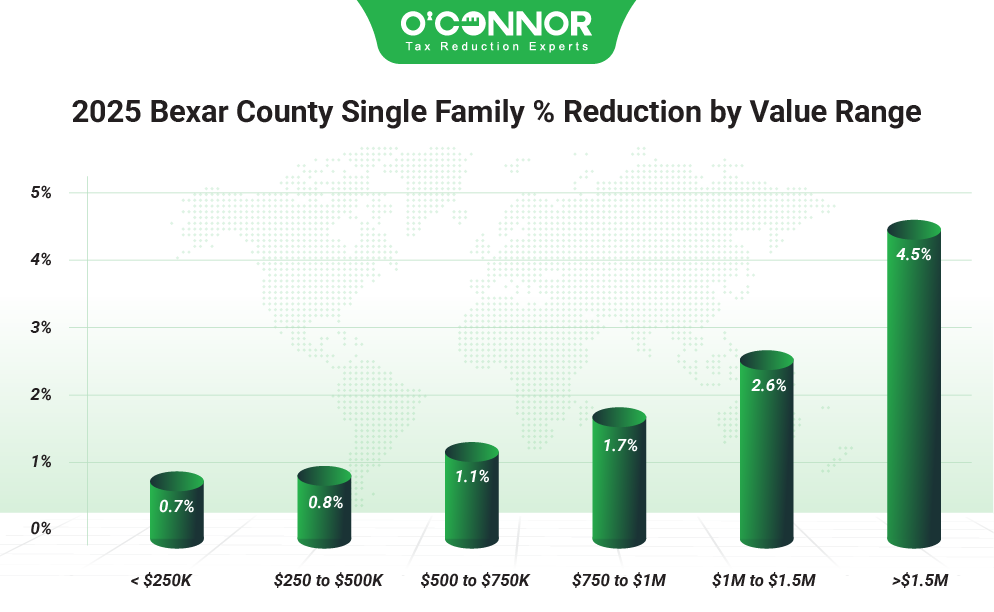
Partially thanks to the success of appeals, Bexar County did not see the huge increases that places like Travis or Denton counties did. Home value increased by 2.2% in 2025. While this was eventually lowered 0.7% thanks to informal appeals, formal appeals to the appraisal review board (ARB) brought the total to 1.1%. The new combined value for all homes dropped to $186.96 billion. About $86.42 billion of this value came from homes worth between $250,000 and $500,000, while $48.31 billion came from those worth under $250,000. These properties had been reduced by 0.8% and 0.7% respectively. The percentage of savings increased as the cost of homes did, with those worth between $750,000 and $1 million being reduced by 1.7%, while those worth over $1.5 million saw a reduction of 4.5%.
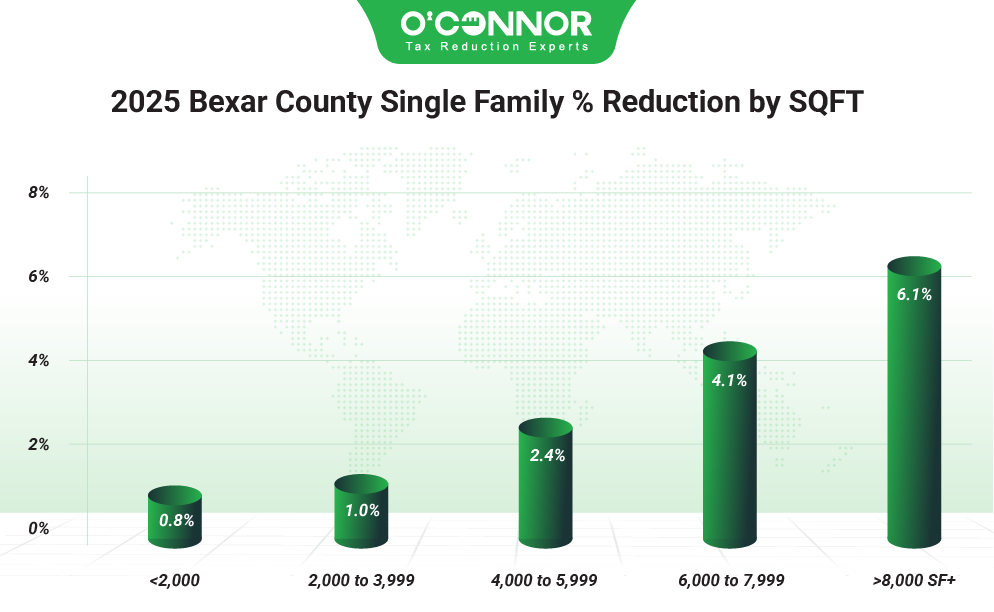
Despite the large value of homes, most were modest, reflecting the roots of Bexar County. $88.98 billion in value came from homes between 2,000 and 3,999 square feet, after a savings of 1%. Approximately $81.39 billion was sourced from homes under 2,000 square feet after a reduction of 0.8%. The only other category to not be a tiny fraction was homes measuring between 4,000 and 5,999 square feet, which reached $11.41 billion in value after a cut of 2.4%. The two largest home categories saved 4.1% and 6.1% respectively, though they were small contributors to the overall total.
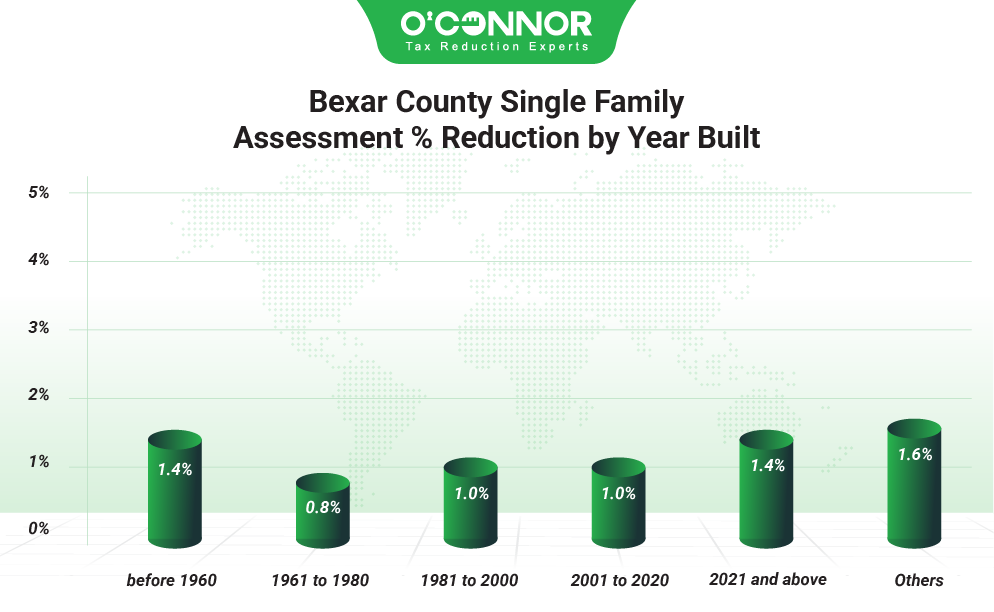
Bexar is one of the oldest counties in Texas and this certainly comes across when homes are looked at by age of construction. While the construction boom of 2001 to 2020 was responsible for 37.8% of all housing value, after a reduction of 1%, older homes provided a good deal of the tax base as well. Accounting for $41.44 billion after a cut of 1%, homes built between 1981 and 2000 were responsible for 22.4% of all value. The two oldest home categories contributed 14% each, while raw land was responsible for $3.01 billion after a reduction of 1.6%. New construction saw an appeal reduction of 1.4% but still managed a solid total of $18.25 billion.
Commercial Protests Nearly Wipe Out Gains
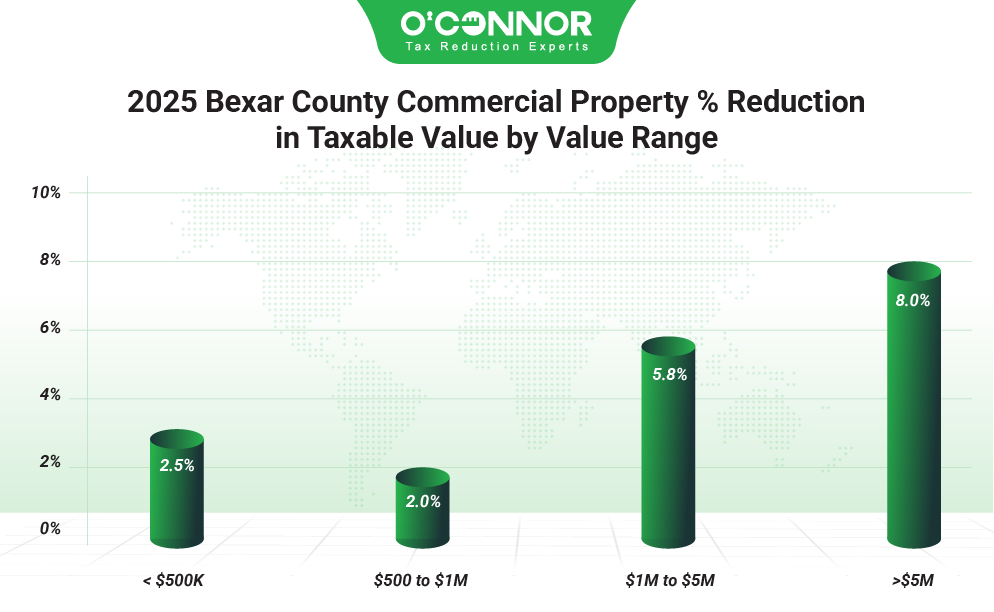
While homes saw only a small jump, commercial properties were rocked with a much higher increase of 7.5%, which resulted in a total of $58.24 billion. Initial appeals reduced this gain with a cut of 6.7%, which was accelerated by ARB hearings that bumped the final reduction to 7.1%. $42.74 billion of the total value came from business properties worth over $5 million, though this was sliced 8% to $39.31 billion. Commercial properties worth between $1 million and $5 million shrank 5.8% thanks to all appeals, resulting in a sum of $10.08 billion. The smallest of businesses saw a reduction of 2.5%, which left a total of $2.11 billion.
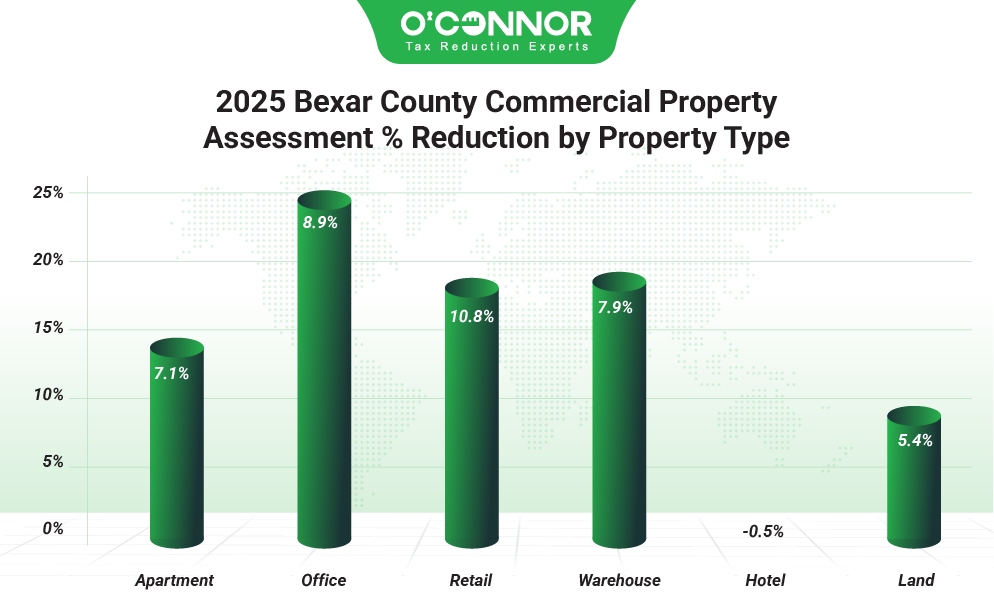
While Bexar County has a diversified economy, like most urban areas, apartments are the No. 1 source of value. After a dramatic cut of 7.1%, apartments saw their total fall to $22.49 billion. Retail was third place in value, despite a giant reduction of 10.8%. Offices were in fourth place with $7.93 billion after a sizeable decrease of 8.9%. Raw land was a huge factor as well, totaling $9.26 billion after a reduction of 5.4%. Though they only reached a total of $2.05 billion, warehouses got trimmed significantly by 7.9%.
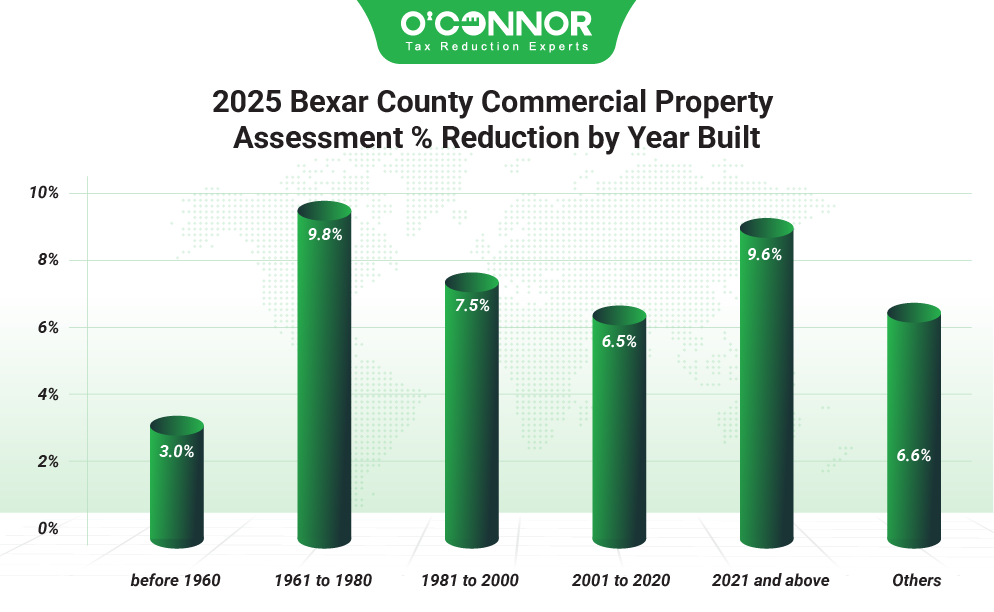
While the age of construction for homes was spread out, commercial property has a strong recency bias. 41.3%, or $23.89 billion in value, was constructed between 2001 and 2020, though this was eventually protested down by 6.5%. About $12.16 billion was created between 1981 and 2000, after a large cut of 7.5%. New construction initially added a staggering 56.1% to its value in 2025, though a concerted appeal effort managed to claw back 9.6%, translating into a total of $3.93 billion. With a reduction of 7.5%, properties built between 1981 and 2000 achieved a total of $12.16 billion.
Informal and Formal Appeals Save Apartment Owners 7.1%
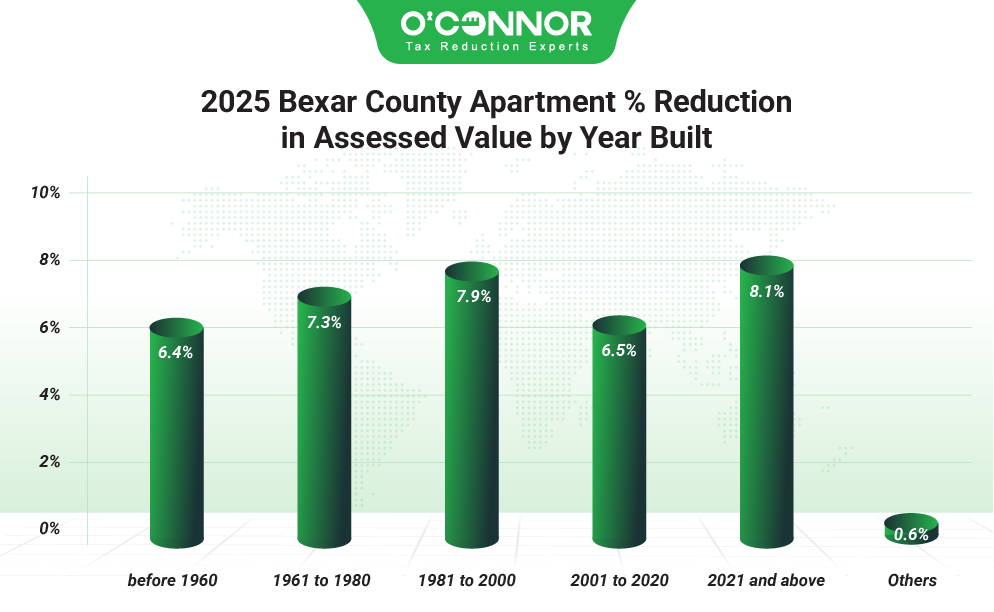
Apartments are the primary commercial property for many counties around the state and Bexar certainly follows this pattern. Of the $22.49 billion total, 51% of it came from apartments built between 2001 and 2020, and this was after a reduction of 6.5%. Those built from 1981 to 2020 were accountable for $5.16 billion after a cut of 7.9%. Older multifamily buildings constructed between 1961 and 1980 managed a reduction of 7.3%, which brought them to a sum of $2.76 billion. New construction quickly climbed the charts and was responsible for $2.66 billion after a large reduction of 8.6%.
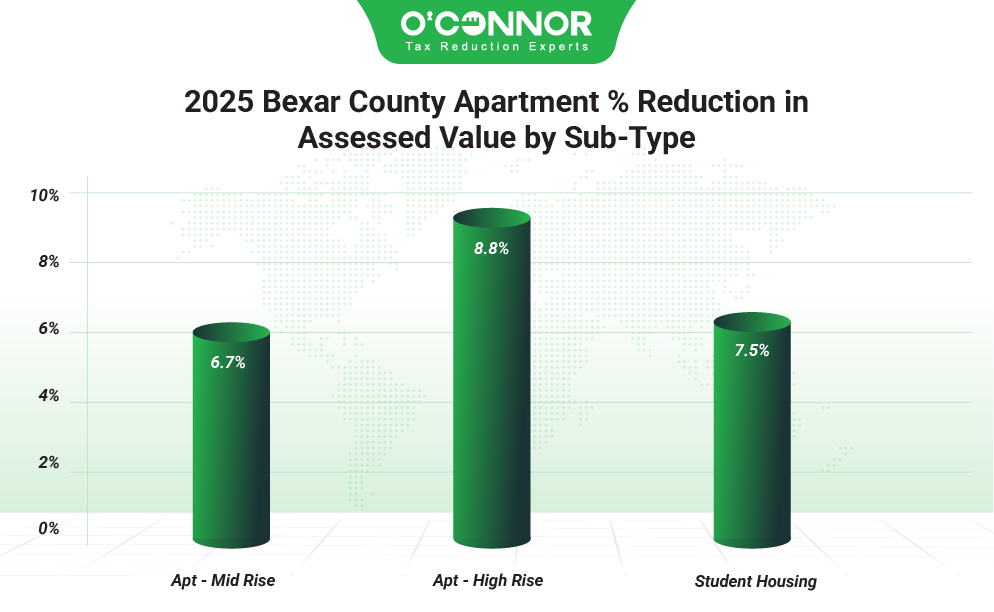
BCAD only divided apartments into three categories for measurement purposes. Mid-rise apartments were easily the No. 1 category with $17.65 billion in value after a reduction of 6.7%. High-rises were second with $4.24 billion, though they landed a large cut of 8.8%. Student housing came in a very distant third with $593.84 million after a drop of 7.5% thanks to appeals.
Offices Managed to Reduce the Value of New Construction 35.7%
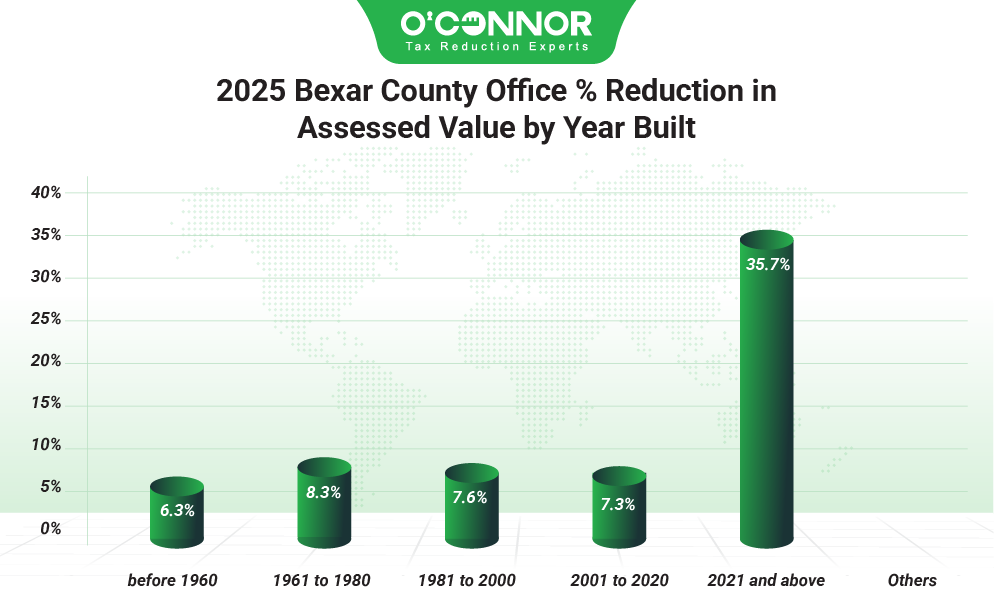
Offices only trailed apartments and raw land in value and experienced an increase of 5.6% in 2025. Thanks to protests by owners, this spike was totally wiped out by a reduction of 8.9%. Totaling $3.57 billion after a solid cut of 7.3%, offices built between 2001 and 2020 were responsible for 45% of all value. Those built between 1981 and 2000 added $2.77 billion to the total, which was achieved after a reduction of 7.6%. The largest jump in value came from new construction, which added 31.8% in 2025. This was not only mitigated but completely reversed thanks to an appeal slicing of 35.7%. This pushed the new total to just $292.72 million.
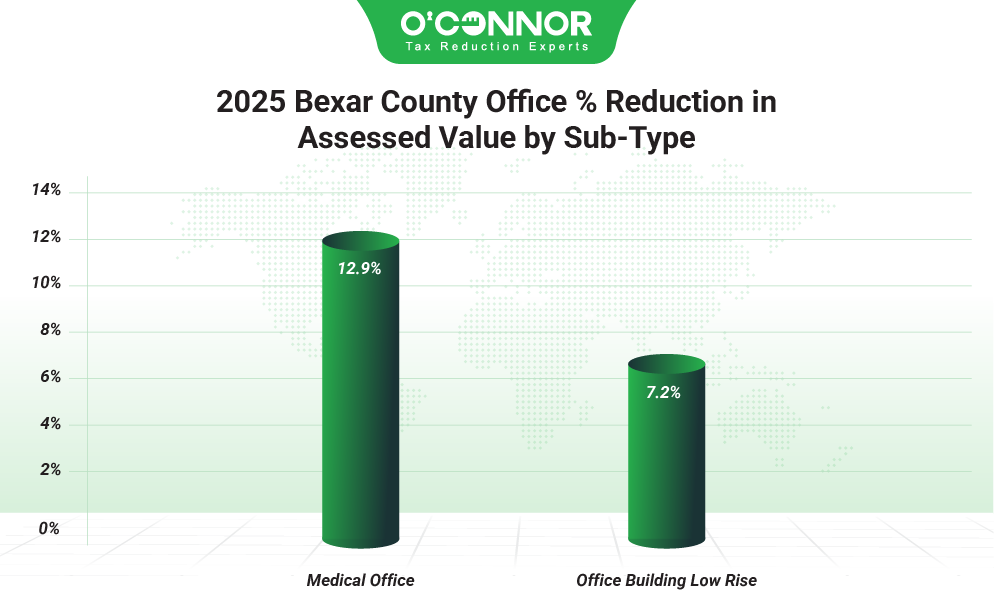
BCAD decided to break down offices into just two groups. Low-rise offices were reduced by 7.2%, leaving them with a sum of $5.65 billion. Medical offices, on the other hand, got a cut of 12.9%, resulting in a total of $2.28 billion. Medical offices had seen a giant growth spike of $15.3%, so reductions were able to almost totally negate it.
Retail Spaces Fall by 10.8%
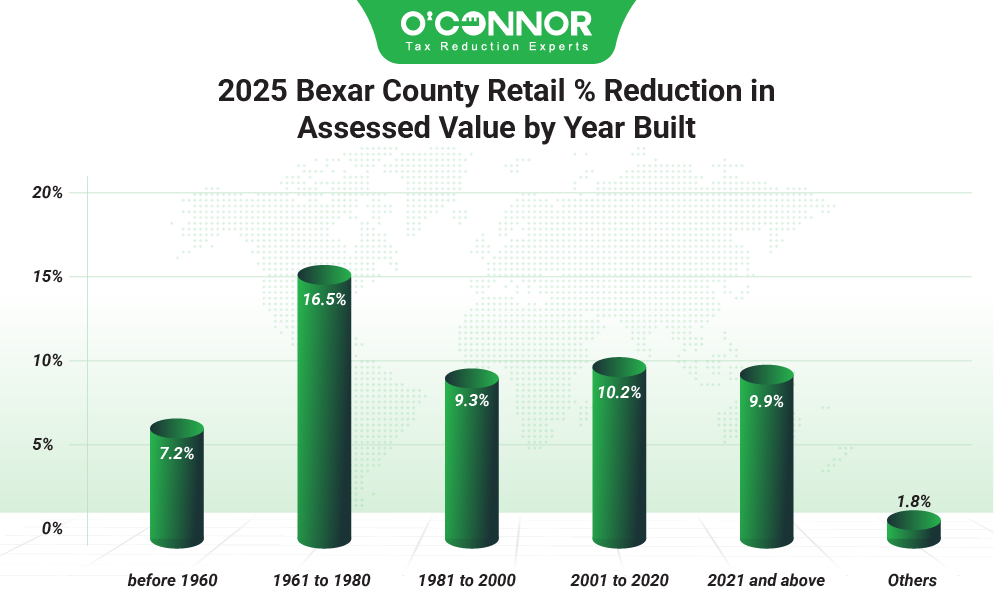
Retail properties saw a dramatic increase in value of 15.2%, which equaled out to a total of $9.16 billion. It did not take long for appeals to oppose this, with an eventual combined drop of 10.8%. With a total of $3.83 billion after a large reduction of 10.2%, retail spaces built between 2001 and 2020 were in the No. 1 spot. Those built from 1981 to 2000 took second place with a combined value of $1.92 billion after a reduction of 9.3%. New construction added 49.8% more value in 2025, but this was cut 9.9% by appeal, leaving a total of $385.06 million. The largest reduction by percentage was a slicing of 16.5% from retail stores built between 1961 and 1980.
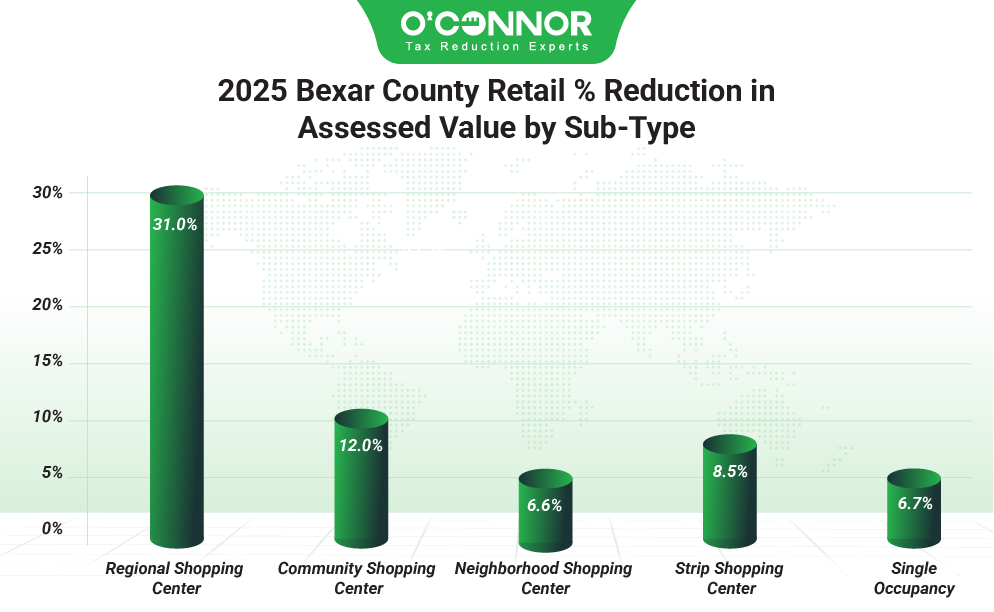
BCAD broke down retail stores into several types, making it easier to study them. The Texas-favorite strip malls were on top with $2.6 billion after a cut of 8.5%, while neighborhood shopping centers managed to reach $2.31 billion despite a reduction of 6.6%. Single-occupancy stores made it to third place with $1.71 billion after a decrease of 6.7%. The largest decrease came for regional shopping centers, which dropped an astounding 31% to a new total of $808.47 million.
Record Warehouse Increase Partially Blunted with Appeals
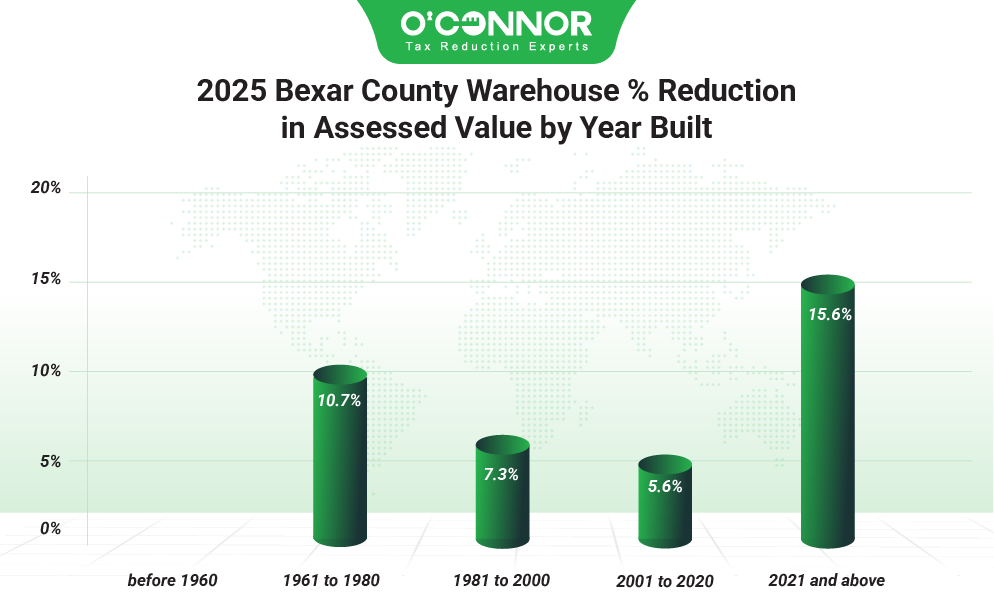
Warehouses make up a tiny fraction of Bexar County’s commercial real estate, which is rare in Texas. Things may not be staying that way, as these storage buildings added 14.5% to their total, reaching $2.05 billion in 2025. This was quickly countered, first by informal appeals, and then by ARB hearings, with an eventual reduction of 7.9%. 52.9%, or $999.8 million was built between 2001 and 2020, which was after a decrease of 5.6% thanks to protests. $484.95 million came from those built between 1981 and 2000, following a reduction of 7.3%. New construction was the main reason for the overall gain, and these warehouses added an enormous 77.8% to their total, achieving $279.80 million. This was eventually reduced to $236.25 million thanks to a protest reduction of 15.6%.
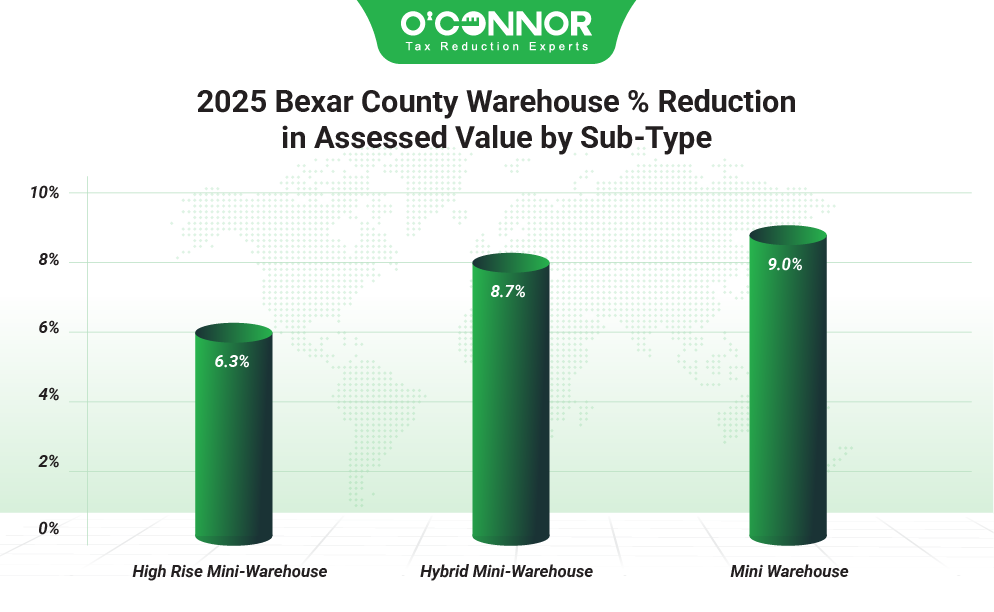
There were only three subtypes of warehouses, according to BCAD. Hybrid warehouses were in the top spot with a total of $936.28 million following a reduction of 8.7%. High-rise warehouses decreased by 6.3%, while mini warehouses dropped 9%. These were responsible for $693.44 million and $262.02 million respectively.
Professionals Like O’Connor can Help the Protest Process
In 2023, 99% of homeowners and 98% of business owners in Bexar County were able to get a reduction through informal means, while ARB hearings were decided in favor of taxpayers 99% and 84% of the time respectively. With BCAD being so generous, any taxpayers that fail to protest in Bexar County are simply leaving money on the table. Besides the obvious windfall, residents should protest based on the implications. If BCAD rolls over so easily, then it means that homes and businesses are being blatantly over assessed. It was estimated that 40% of homes alone were overvalued in 2025. With a litany of issues that can be easily rectified, property tax appeals in the San Antonio area are almost mandatory.
To maximize your reduction, you can always enlist a property tax firm to help you navigate the complex web of rules required. In 2025, we at O’Connor saved our clients $193.10 million in taxable value for Bexar County. As one of the biggest property tax firms in the United States, we were able to help 185,000 clients in 2024 alone, with Bexar being one of our many success stories. There is no cost to enroll with us, and you will never see a hidden fee or upfront charge. You only pay from your savings if we can lower your taxes. We will also automatically appeal your taxes every year, ensuring you are always getting the best deal and benefiting from compounding victories.

